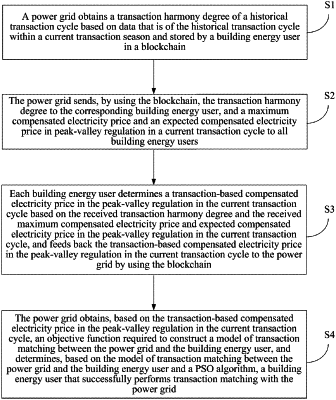| CPC G05B 19/042 (2013.01) [G05B 2219/2639 (2013.01)] | 9 Claims |

|
1. A transaction harmony degree-based method for transaction matching between a power grid and building energy, comprising:
obtaining, by a power grid, a transaction harmony degree of a historical transaction cycle based on data that is of the historical transaction cycle within a current transaction season and stored by a building energy user in a blockchain;
sending, by the power grid by using the blockchain, the transaction harmony degree to the corresponding building energy user, and sending a maximum compensated electricity price and an expected compensated electricity price in peak - valley regulation in a current transaction cycle to all building energy users;
determining, by each building energy user, a transaction-based compensated electricity price in the peak-valley regulation in the current transaction cycle based on the received transaction harmony degree and the received maximum compensated electricity price and expected compensated electricity price in the peak-valley regulation in the current transaction cycle, and feeding back the transaction-based compensated electricity price in the peak-valley regulation in the current transaction cycle to the power grid by using the blockchain; and
obtaining, by the power grid based on the transaction-based compensated electricity price in the peak-valley regulation in the current transaction cycle, an objective function required to construct a model of transaction matching between the power grid and the building energy user, and determining, based on the model of transaction matching between the power grid and the building energy user and a particle swarm optimization (PSO) algorithm, a building energy user that successfully performs transaction matching with the power grid; wherein
the objective function is determined with an objective of maximizing a transaction harmony degree between the power grid and the building energy user and minimizing a compensation cost in the peak-valley regulation of the power grid; and
the model of transaction matching between the power grid and the building energy user is composed of the objective function, a first constraint, and a second constraint; wherein
after the determining, based on the model of transaction matching between the power grid and the building energy user, a building energy user that successfully performs transaction matching with the power grid, the method further comprises:
determining, by the power grid, an agreed electricity quantity in peak regulation in the current transaction cycle and an agreed electricity quantity in valley regulation in the current transaction cycle based on the model of transaction matching between the power grid and the building energy user; and
sending, by the power grid by using the blockchain, the agreed electricity quantity in the peak regulation in the current transaction cycle and the agreed electricity quantity in the valley regulation in the current transaction cycle to the building energy user with successful transaction matching.
|